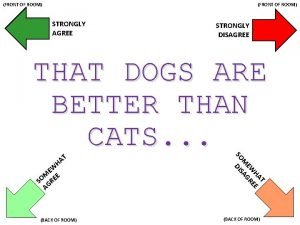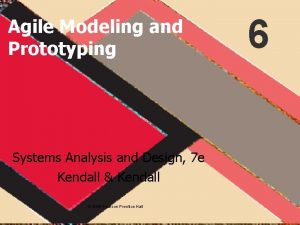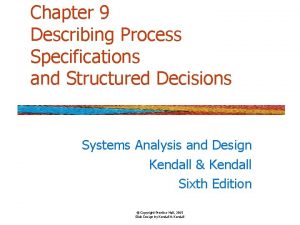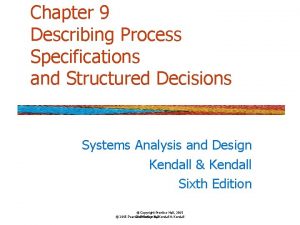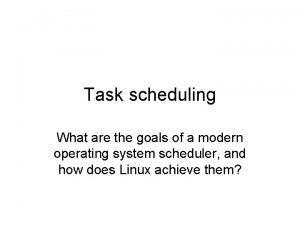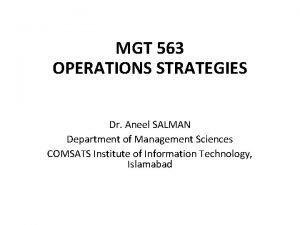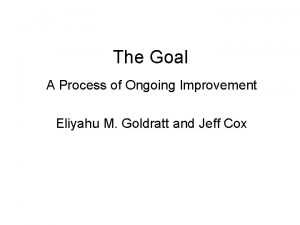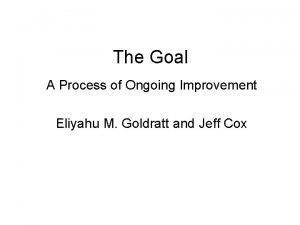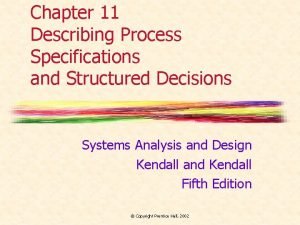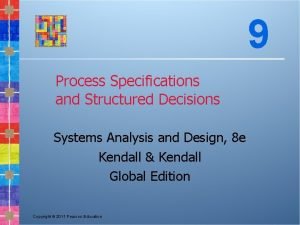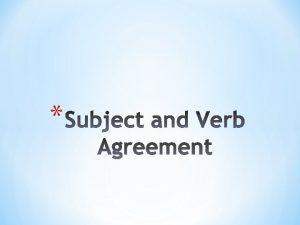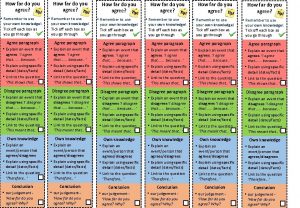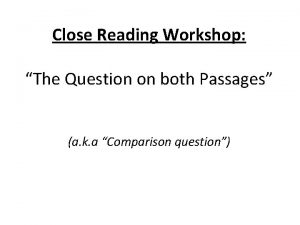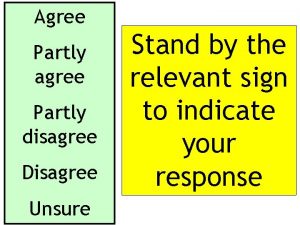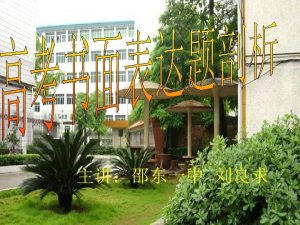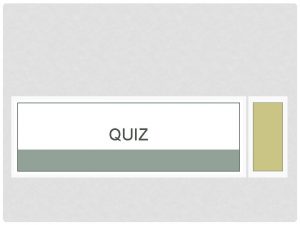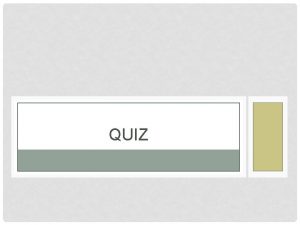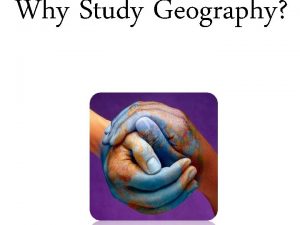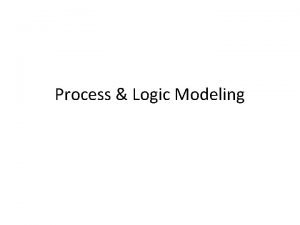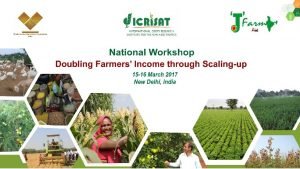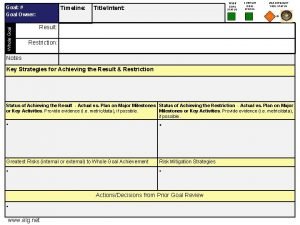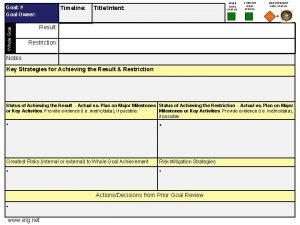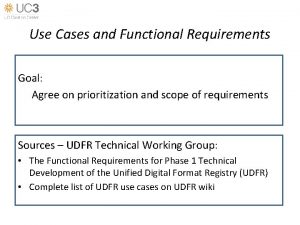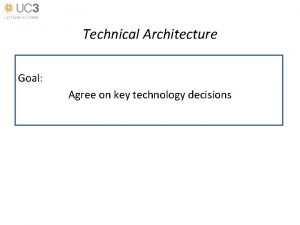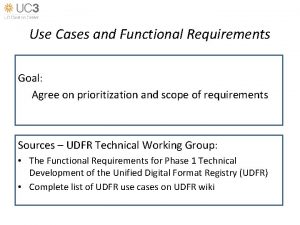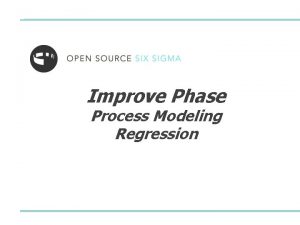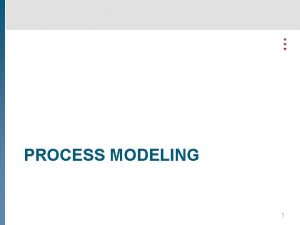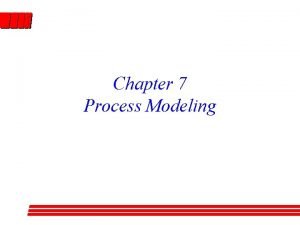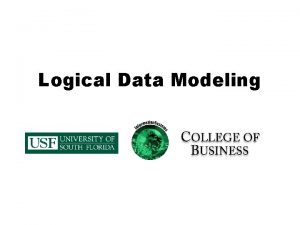Data modeling Goal Agree on data modeling process




















- Slides: 20

Data modeling Goal: Agree on data modeling process and ontology

Agenda 1. 2. 3. 4. 5. Scope Provenance/ Governance (briefly) Identifiers Guiding Principles, Terms, Concepts Controlled Vocabularies

Scope Current model is based on PRONOM 6 and UDFR Is there a useful distinction between “fact” and “institutional policy”? What should be contained in the registry? Fact JPG 2000 is an image compression format. Assessment JPEG 2000 is a welladopted standard. Policy JPG 2000 is acceptable by CDL for reformatting photographs

Scope Are there other aspects of PRONOM 7 we want to include in the registry?

Provenance (briefly) Representation within the model is statements about the provenance Statements about the formats, rather than who stated those facts. Provenance about the registry information itself can be managed by Open Provenance Vocabulary whether as reified statements or statements about particular triples or graphs. What is the proper granularity for provenance and technical review, perproperty or per-aggregate entity (e. g. , format, agent, document, etc)

Governance (briefly) More food for thought (to be extended tomorrow): What level of technical review should/will contributed information be subject, and by whom? What are the criteria for contributor eligibility? Anonymous? Public, but known? Self-nominated, but vetted? Invited?

Identifiers (1) There are multiple identifiers that are defined in the model: 1. PRONOM ID (PUID) 2. GDFR Identifier 3. UDFR Identifier 4. UDFR System. ID (internal registry ID)

Identifiers (2) UDFR Identifier: • A globally unique identifier across registry instances • A persistent identifier • Can be ported to persistent space at later time • Non-opaque • identical or mappable to URI local name • machine-actionable Should UDFR identifier be opaque or transparent?

Identifiers (3) Node Create a zero-padded numeric sequence for organizational node ids (e. g. “ 001”) to be used within the identifier. Format Keep version information as it is defined idiosyncractically by the original format creator. Parse it to reveal family and other useful categorizations.

Identifiers (4) UDFRID = (addressable-prefix , “/” , identifier )| (addressable-prefix , “#” , identifier); addressable-prefix = “http: //udfr. org/udfr” | (“http: //n 2 t. net/” , udfr-ezid) ; udfr-ezid = 5 * digit ; identifier = node-id , “/” , entity-code , “/” , local-id , “/” , version-id ; node-id = 3 * digit ; entity-code = “f” | “n” local-id = alpha , {alphanumeric-with-slash} ; version-id digit = [0 – 9] ; alpha = [a-z. A-Z] ; alphanumeric = [alpha | digit] alphanumeric-with-slash = [alphanumeric | “/”]. For example: http: //udfr. org/udfr/001/f/pdf/a/1 http: //udfr. org/udfr/001/f/pdf/1. 7

Goals and guiding principles 1. Support existing functionality and use cases 2. Reuse and map to existing ontologies where it makes sense (“linked data”) 3. Primarily be a descriptive ontology, with the goal of expanding to machine-actionable semantic representations where needed 4. Create natural partitions to modularize 5. Enable for expansion 6. Be consistent 7. Have the application be model-driven (yet domain model-agnostic) as much as possible

Terms Resource An object or element expressed in RDF. A resource is identified by a URI. Class Typically represents a concept. A set of individuals which may possess a set of properties or relationships. Instance An individual member of a class. Property Represents a relationship or attribute. Owl divides properties into Object Properties, which relate two resources and Datatype Properties, which relate a resource to a datatype.

Conceptual Entities Simple. Base. Entity – Contains all basic provenance/governance properties such as: • administrative. Status • base. Note • identifier • creation. Date, modification. Date • veritication. Date, verification. Status, verified. By

Conceptual Entities Core. Entity – Classes where the circumstance of its creation are meaningful: • Assessment • Document • File • Format: Character. Encoding, Compression. Technique, File. Format • Holding • Identifier • Intellectual. Property. Rights. Claim • Product: Hardware and Software Products Has additional properties relating to release information and agents who created them.

Conceptual Entities Enumerated. Types – Class of Enumerated Type Classes (List of Values) as well as the GDFR Facets. Examples include: • Byte. Order. Type • Compression. Family. Teyp • Country. Code • Disclosure. Type • Document. Intent. Type • Format. Role. Type • Language. Code • Media. Type

Conceptual Entities Format – use GDFR definition of Format to include: • File Format • Character Encoding • Compression Technique Most properties are defined at Format level (to be inherited by subclasses) Should we use GDFR definition of Format?

Properties Should the registry support actionable inheritance of properties? For example, should BWF automatically inherit all properties defined for “generic” WAVE? When should inference take place? At UI entry time? Current relationships from GDFR (restricted, extended, …) may be difficult to formalize. Shall we just replace with “is. Derived. From” property?

Controlled Vocabularies Semantic: RDF, RDFS, OWL Vocabulary/Thesaurus: SKOS Metadata: DC, DCTERMS Agents: FOAF Provenance: OPMV (Open Provenance model Vocabulary) Country Codes/ Language Codes Organization IDs MIME Types Governance ?


Questions/ Concerns ?
 Agree disagree
Agree disagree What is the primary goal in agile modeling
What is the primary goal in agile modeling Helen c erickson
Helen c erickson Relational modeling vs dimensional modeling
Relational modeling vs dimensional modeling Four-model approach
Four-model approach Dfd chapter 5
Dfd chapter 5 Best practices for data warehousing
Best practices for data warehousing Process specifications
Process specifications A goal of producing process specifications is to
A goal of producing process specifications is to What are the goal(s) for process scheduling?
What are the goal(s) for process scheduling? Aneel salman
Aneel salman Incremental utilization heuristic
Incremental utilization heuristic The goal: a process of ongoing improvement
The goal: a process of ongoing improvement The goal boy scout hike
The goal boy scout hike A goal of producing process specifications is to:
A goal of producing process specifications is to: Structured english in system analysis and design
Structured english in system analysis and design Must agree in number with the noun
Must agree in number with the noun Italicized pronoun examples
Italicized pronoun examples How far do you agree
How far do you agree You are what you eat do you agree or disagree
You are what you eat do you agree or disagree Which two points do the two passages agree on?
Which two points do the two passages agree on?
